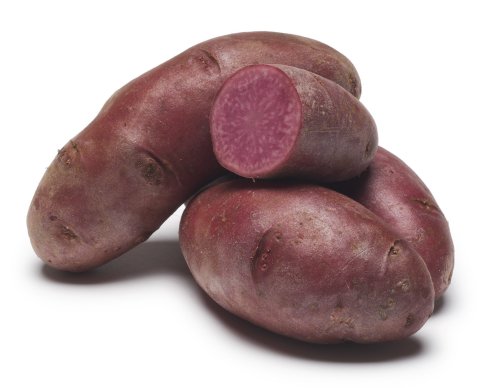
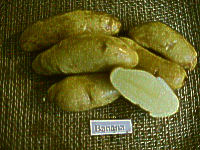

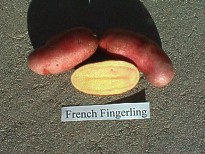
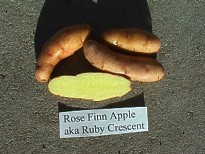
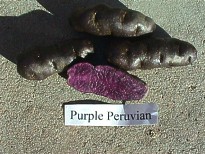
 |
 |
 |
| Amarosa - Red skin red flesh fingerling | Banana - yellow fingerling, industry standard | Austrian Crescent - early season, high yielding yellow fingerling |
 |
 |
 |
| French Fingerling - Red skinned yellow flesh with red swirl, nutty favor | Rose Finn Apple also known as Ruby Crescent - Pink skinned yellow flesh fingerling | Purple Peruvian - Purple skinned purple flesh fingerling, very late season |
Fingerlings Fingerlings come in many colors but generally have a long thin shape. The French fingerling is the only one in this list that has problems getting too fat. The rest just get longer as they grow. Fingerlings generally are easy to grow and have big wild type plants. They have few disease problems. They have good taste and textures and are often marketed in mixed fresh packs.
Plant/roots Fingrlings are all fast emerging with a medium to large vines. Fingerlings has a indeterminate growth habit and a moderate to deep, wide root systems.
Yields potential 150 to 300 cwt. range. The biggest challenge with fingerlings is getting them to the cellar
as many fall out of the harvestor chains.
Irrigation
Irrigation interval at the maximum ET is 3 days. Drought tolerance is excellent. Many fingerlings always seen dry around the rootball but don't overwater them as this is worse.
The Rose Finn Apple, Austrian Crescent and Purple Peruvian dry out fast just below the plant, but will do fine. The other are easier to overwater. Since they are often
grown together find a unhappy medium in watering.
Insects: Standard insect control measures generally are effective.
Fungicides Control of foliar early blight usually requires zero to four fungicide applications.
Tuber/bulking Tuber set good and in the center of the hill in some varieties but often very spread out..
Tuberization occurs early and tubers bulk at a even rate thoughout the season. Most mature early but the pueple peruvian is very late season. Tubers are resistant
to second growth except for the Rose Finn Apple.
Vine kill Average days from planting to vine kill vary from 90 days to 150. Vine killing is always required in most
years and can be a problem if plants are not mature. A Second killing operation may be necessary. Adequate skin set occurs within 21 days on
most varieties except the French Fingerling which requires 30 days at least.
Tubers do not have much problems with shatter bruise, but can be injured easily so care should be taken in handling.
| Field | Storage |
| Foliar early blight: Moderate | Tuber early blight Resistant |
| Verticillium wilt: Resistant | Bacterial soft rot Moderately Susceptible |
| Blackleg Moderately Susceptible | Fusarium dry rot Moderately Susceptible |
| Seedpiece decay Moderate | Leak (Pythium) Moderately resistant |
| Leafroll virus Resistant | Pink rot (Phytophthora) Moderately Resistant |
| Leafroll Net necrosis Resistant | Silver scurf Moderately Resistant |
| PVY, PVX Susceptable to Resistant | Rhizoctonia scurf Resistant |
| Bacterial ring rot Moderate | Powdery Scab Susceptible |
| Common Scab Susceptible |
Disease reaction ratings susceptible, moderately susceptible, moderate, moderately resistant and resistant.
Note: This information should only be used as a guide. Adjustments for local conditions must always be made.